Study on the Rheological and Thixotropic Properties of Fiber-Reinforced Cemented Paste Backfill Containing Blast Furnace Slag
Abstract
:1. Introduction
2. Experimental Materials and Methods
2.1. Experimental Materials
2.1.1. Tailings
2.1.2. Cementitious Materials and Water
2.1.3. Fiber
2.2. Experimental Methods
2.2.1. Determination of Packing Density
2.2.2. Determination of WFT
2.2.3. Determination of Yield Stress and Thixotropy
3. Results and Discussions
3.1. Packing Density and WFT
3.1.1. Effect of Water Content on Solid Concentration
3.1.2. Effect of PPF on Packing Density
3.1.3. Effect of PPF on WFT
3.2. Rheological Properties
3.3. Discussion
4. Conclusions
- The packing density obtained by the wet packing test is greater than that obtained by the dry packing test. Compared with the dry packing test, the wet packing test is more suitable for measuring the packing density of the tailings-binder-PPF (TBP) system.
- As the PPF content increases, the packing density of the TBP system first increases and then decreases. The increase in packing density is due to the filling effect of the fibers, while the decrease is attributed to the wedging effect. In addition, the PPF length has a slight adverse effect on the packing density.
- The thixotropy of CPB exhibits a characteristic of stability followed by an increase with the addition of PPF. The critical PPF content for these two trends is 0.2%, at which point the system achieves its maximum packing density. Packing density is an important factor affecting the thixotropy of fresh FRCPB, but interactions among the fibers cannot be ignored.
- The WFT tends to increase and then decrease with the PPF content. Moreover, there is a good linear relationship between WFT and the yield stress of fresh FRCPB. Therefore, WFT can be used to predict the yield stress of FRCPB.
- The optimal PPF content was determined to be 0.2%, with a fiber length of 6 mm. This combination provides the best performance in terms of yield stress, thixotropy, and overall transport properties, making it suitable for use in CPB applications.
Author Contributions
Funding
Data Availability Statement
Conflicts of Interest
References
- Solismaa, S.; Torppa, A.; Kuva, J.; Heikkilä, P.; Hyvönen, S.; Juntunen, P.; Benzaazoua, M.; Kauppila, T. Substitution of Cement with Granulated Blast Furnace Slag in Cemented Paste Backfill: Evaluation of Technical and Chemical Properties. Minerals 2021, 11, 1068. [Google Scholar] [CrossRef]
- Bull, A.J.; Fall, M. Thermally Induced Changes in Metalloid Leachability of Cemented Paste Backfill That Contains Blast Furnace Slag. Miner. Eng. 2020, 156, 106520. [Google Scholar] [CrossRef]
- Sagade, A.; Fall, M. Study of Fresh Properties of Cemented Paste Backfill Material with Ternary Cement Blends. Constr. Build. Mater. 2024, 411, 134287. [Google Scholar] [CrossRef]
- Ouattara, D.; Mbonimpa, M.; Yahia, A.; Belem, T. Assessment of Rheological Parameters of High Density Cemented Paste Backfill Mixtures Incorporating Superplasticizers. Constr. Build. Mater. 2018, 190, 294–307. [Google Scholar] [CrossRef]
- Al-Bakri, A.Y.; Ahmed, H.M.; Hefni, M.A. Experimental Investigation of Recycling Cement Kiln Dust (CKD) as a Co-Binder Material in Cemented Paste Backfill (CPB) Made with Copper Tailings. Minerals 2024, 14, 750. [Google Scholar] [CrossRef]
- Dhers, S.; Guggenberger, R.; Freimut, D.; Fataei, S.; Schwesig, P.; Martic, Z. Impact of Admixtures on Environmental Footprint, Rheological and Mechanical Properties of LC3 Cemented Paste Backfill Systems. Minerals 2023, 13, 1552. [Google Scholar] [CrossRef]
- Koc, E.; Cihangir, F. Ultrasonic and Microstructural Evaluation of Sulphide-Rich Tailings Cemented Paste Backfill Properties Containing Alkali-Activated Slag: Effect of Slag Fineness. Minerals 2023, 13, 1524. [Google Scholar] [CrossRef]
- Cacciuttolo, C.; Marinovic, A. Experiences of Underground Mine Backfilling Using Mine Tailings Developed in the Andean Region of Peru: A Green Mining Solution to Reduce Socio-Environmental Impacts. Sustainability 2023, 15, 12912. [Google Scholar] [CrossRef]
- Guo, Z.; Qiu, J.; Pel, L.; Zhao, Y.; Zhu, Q.; Kwek, J.W.; Zhang, L.; Jiang, H.; Yang, J.; Qu, Z. A Contribution to Understanding the Rheological Measurement, Yielding Mechanism and Structural Evolution of Fresh Cemented Paste Backfill. Cem. Concr. Compos. 2023, 143, 105221. [Google Scholar] [CrossRef]
- Chakilam, S.; Cui, L. Effect of Polypropylene Fiber Content and Fiber Length on the Saturated Hydraulic Conductivity of Hydrating Cemented Paste Backfill. Constr. Build. Mater. 2020, 262, 120854. [Google Scholar] [CrossRef]
- Libos, I.L.S.; Cui, L. Time-and Temperature-Dependence of Compressive and Tensile Behaviors of Polypropylene Fiber-Reinforced Cemented Paste Backfill. Front. Struct. Civ. Eng. 2021, 15, 1025–1037. [Google Scholar] [CrossRef]
- Li, Z.; Shi, X.; Chen, X. Effect of Rice Straw on Tensile Properties of Tailings Cemented Paste Backfill. Appl. Sci. 2022, 12, 526. [Google Scholar] [CrossRef]
- Chen, X.; Jiao, H.; Liu, J.; Yang, Y.; Chen, X.; Yang, L.; Zhang, W.; Yang, T. The Influence of Multi-Size Basalt Fiber on Cemented Paste Backfill Mechanical Properties and Meso-Structure Characteristics. Minerals 2023, 13, 1215. [Google Scholar] [CrossRef]
- Xue, G.; Yilmaz, E.; Song, W.; Cao, S. Fiber Length Effect on Strength Properties of Polypropylene Fiber Reinforced Cemented Tailings Backfill Specimens with Different Sizes. Constr. Build. Mater. 2020, 241, 118113. [Google Scholar] [CrossRef]
- Xue, G.; Yilmaz, E.; Song, W.; Yilmaz, E. Influence of Fiber Reinforcement on Mechanical Behavior and Microstructural Properties of Cemented Tailings Backfill. Constr. Build. Mater. 2019, 213, 275–285. [Google Scholar] [CrossRef]
- Xue, G.; Yilmaz, E. Strength, Acoustic, and Fractal Behavior of Fiber Reinforced Cemented Tailings Backfill Subjected to Triaxial Compression Loads. Constr. Build. Mater. 2022, 338, 127667. [Google Scholar] [CrossRef]
- Cao, S.; Yilmaz, E.; Song, W. Fiber Type Effect on Strength, Toughness and Microstructure of Early Age Cemented Tailings Backfill. Constr. Build. Mater. 2019, 223, 44–54. [Google Scholar] [CrossRef]
- Chen, X.; Shi, X.; Zhou, J.; Chen, Q.; Li, E.; Du, X. Compressive Behavior and Microstructural Properties of Tailings Polypropylene Fibre-Reinforced Cemented Paste Backfill. Constr. Build. Mater. 2018, 190, 211–221. [Google Scholar] [CrossRef]
- Sun, K.; Fall, M. Response Surface Methodology-Based Characterization and Optimization of Fibre Reinforced Cemented Tailings Backfill with Slag. Int. J. Min. Reclam. Environ. 2023, 37, 735–759. [Google Scholar] [CrossRef]
- Cui, L.; McAdie, A. Experimental Study on Evolutive Fracture Behavior and Properties of Sulfate-Rich Fiber-Reinforced Cemented Paste Backfill under Pure Mode-I, Mode-II, and Mode-III Loadings. Int. J. Rock Mech. Min. Sci. 2023, 169, 105434. [Google Scholar] [CrossRef]
- Guo, Z.; Qiu, J.; Kirichek, A.; Zhou, H.; Liu, C.; Yang, L. Recycling Waste Tyre Polymer for Production of Fibre Reinforced Cemented Tailings Backfill in Green Mining. Sci. Total Environ. 2024, 908, 168320. [Google Scholar] [CrossRef] [PubMed]
- Haiqiang, J.; Fall, M.; Cui, L. Yield Stress of Cemented Paste Backfill in Sub-Zero Environments: Experimental Results. Miner. Eng. 2016, 92, 141–150. [Google Scholar] [CrossRef]
- Carnogursky, E.A.; Fall, M.; Haruna, S. Rheology and Setting Time of Saline Cemented Paste Backfill. Miner. Eng. 2023, 202, 108258. [Google Scholar] [CrossRef]
- Kou, Y.; Jiang, H.; Ren, L.; Yilmaz, E.; Li, Y. Rheological Properties of Cemented Paste Backfill with Alkali-Activated Slag. Minerals 2020, 10, 288. [Google Scholar] [CrossRef]
- Li, L.G.; Chu, S.H.; Zeng, K.L.; Zhu, J.; Kwan, A.K.H. Roles of Water Film Thickness and Fibre Factor in Workability of Polypropylene Fibre Reinforced Mortar. Cem. Concr. Compos. 2018, 93, 196–204. [Google Scholar] [CrossRef]
- Li, L.G.; Zhao, Z.W.; Zhu, J.; Kwan, A.K.H.; Zeng, K.L. Combined Effects of Water Film Thickness and Polypropylene Fibre Length on Fresh Properties of Mortar. Constr. Build. Mater. 2018, 174, 586–593. [Google Scholar] [CrossRef]
- Li, L.G.; Zeng, K.L.; Ouyang, Y.; Kwan, A.K.H. Basalt Fibre-Reinforced Mortar: Rheology Modelling Based on Water Film Thickness and Fibre Content. Constr. Build. Mater. 2019, 229, 116857. [Google Scholar] [CrossRef]
- Qiu, J.; Guo, Z.; Yang, L.; Jiang, H.; Zhao, Y. Effects of Packing Density and Water Film Thickness on the Fluidity Behaviour of Cemented Paste Backfill. Powder Technol. 2020, 359, 27–35. [Google Scholar] [CrossRef]
- Fung, W.W.S.; Kwan, A.K.H. Role of Water Film Thickness in Rheology of CSF Mortar. Cem. Concr. Compos. 2010, 32, 255–264. [Google Scholar] [CrossRef]
- Kwan, A.K.H.; Fung, W.W.S. Roles of Water Film Thickness and SP Dosage in Rheology and Cohesiveness of Mortar. Cem. Concr. Compos. 2012, 34, 121–130. [Google Scholar] [CrossRef]
- Mater, Y.M.; Elansary, A.A.; Abdalla, H.A. Experimental and Numerical Investigation of Preloaded Recycled Concrete Beams Strengthened with CFRP. World J. Eng. 2024. [Google Scholar] [CrossRef]
- Rathore, S.S.; Meesala, C.R. Influence of Recycled Coarse Aggregate on Properties of Fly Ash and Slag-Based Geopolymer Concrete Cured under Oven and Ambient Temperature. World J. Eng. 2024; ahead of print. [Google Scholar]
- Qiu, J.; Guo, Z.; Yang, L.; Jiang, H.; Zhao, Y. Effect of Tailings Fineness on Flow, Strength, Ultrasonic and Microstructure Characteristics of Cemented Paste Backfill. Constr. Build. Mater. 2020, 263, 120645. [Google Scholar] [CrossRef]
- Guo, Z.; Qiu, J.; Jiang, H.; Xing, J.; Sun, X.; Ma, Z. Flowability of Ultrafine-Tailings Cemented Paste Backfill Incorporating Superplasticizer: Insight from Water Film Thickness Theory. Powder Technol. 2021, 381, 509–517. [Google Scholar] [CrossRef]
- Qi, T.; Gao, X.; Feng, G.; Bai, J.; Wang, Z.; Chen, Q.; Wang, H.; Du, X. Effect of Biomass Power Plant Ash on Fresh Properties of Cemented Coal Gangue Backfill. Constr. Build. Mater. 2022, 340, 127853. [Google Scholar] [CrossRef]
- Fall, M.; Benzaazoua, M.; Ouellet, S. Experimental Characterization of the Influence of Tailings Fineness and Density on the Quality of Cemented Paste Backfill. Miner. Eng. 2005, 18, 41–44. [Google Scholar] [CrossRef]
- Benito, E.K.D.; Aragoncillo, A.M.M.; Pascua, F.A.A.; Juanites, J.M.; Eneria, M.A.; Zafra, R.G.; Madlangbayan, M.S. Durability Performance of Concrete Containing Recycled Coarse Aggregates Derived from Laboratory-Tested Specimens. World J. Eng. 2024, 21, 604–614. [Google Scholar] [CrossRef]
- Margabandu, S.; Subramaniam, S.K. Influence of Fiber Stacking Sequences and Matrix Materials on Mechanical and Vibration Behavior of Jute/Carbon Hybrid Composites. World J. Eng. 2022, 19, 639–651. [Google Scholar] [CrossRef]
- Poodipeddi, S.K.K.; Singampalli, A.; Rayala, L.S.M.; Ravula, S.S.N. Structural and Fatigue Analysis of Car Wheel Rims with Carbon Fibre Composites. World J. Eng. 2024, 21, 503–509. [Google Scholar] [CrossRef]
- Kannan, H.; Prakash, K.S. Improving Structural Performance of Concrete Beams by U-Wrapped Basalt Fibre: A Retrofitting Approach. World J. Eng. 2024, 21, 267–274. [Google Scholar] [CrossRef]
- Li, L.G.; Zhuo, H.X.; Zhu, J.; Kwan, A.K.H. Packing Density of Mortar Containing Polypropylene, Carbon or Basalt Fibres under Dry and Wet Conditions. Powder Technol. 2019, 342, 433–440. [Google Scholar] [CrossRef]
- Wong, H.H.C.; Kwan, A.K.H. Packing Density of Cementitious Materials: Part 1-Measurement Using a Wet Packing Method. Mater. Struct. Constr. 2008, 41, 689–701. [Google Scholar] [CrossRef]
- Li, L.G.; Kwan, A.K.H. Concrete Mix Design Based on Water Film Thickness and Paste Film Thickness. Cem. Concr. Compos. 2013, 39, 33–42. [Google Scholar] [CrossRef]
- Jiang, H.; Fall, M.; Yilmaz, E.; Li, Y.; Yang, L. Effect of Mineral Admixtures on Flow Properties of Fresh Cemented Paste Backfill: Assessment of Time Dependency and Thixotropy. Powder Technol. 2020, 372, 258–266. [Google Scholar] [CrossRef]
- Li, L.G.; Kwan, A.K.H. Packing Density of Concrete Mix under Dry and Wet Conditions. Powder Technol. 2014, 253, 514–521. [Google Scholar] [CrossRef]
- Kwan, A.K.H.; Chan, K.W.; Wong, V. A 3-Parameter Particle Packing Model Incorporating the Wedging Effect. Powder Technol. 2013, 237, 172–179. [Google Scholar] [CrossRef]
- Sultangaliyeva, F.; Carré, H.; La Borderie, C.; Zuo, W.; Keita, E.; Roussel, N. Influence of Flexible Fibers on the Yield Stress of Fresh Cement Pastes and Mortars. Cem. Concr. Res. 2020, 138, 106221. [Google Scholar] [CrossRef]
- Kwan, A.K.H.; Fung, W.W.S. Packing Density Measurement and Modelling of Fine Aggregate and Mortar. Cem. Concr. Compos. 2009, 31, 349–357. [Google Scholar] [CrossRef]
- Li, Y.; Chen, J.J.; Kwan, A.K.H. Roles of Water Film Thickness in Fresh and Hardened Properties of Mortar. Adv. Cem. Res. 2013, 25, 171–182. [Google Scholar] [CrossRef]
- Kwan, A.K.H.; Wong, H.H.C. Effects of Packing Density, Excess Water and Solid Surface Area on Flowability of Cement Paste. Adv. Cem. Res. 2008, 20, 1–11. [Google Scholar] [CrossRef]
- Ferron, R.D.; Shah, S.; Fuente, E.; Negro, C. Aggregation and Breakage Kinetics of Fresh Cement Paste. Cem. Concr. Res. 2013, 50, 1–10. [Google Scholar] [CrossRef]

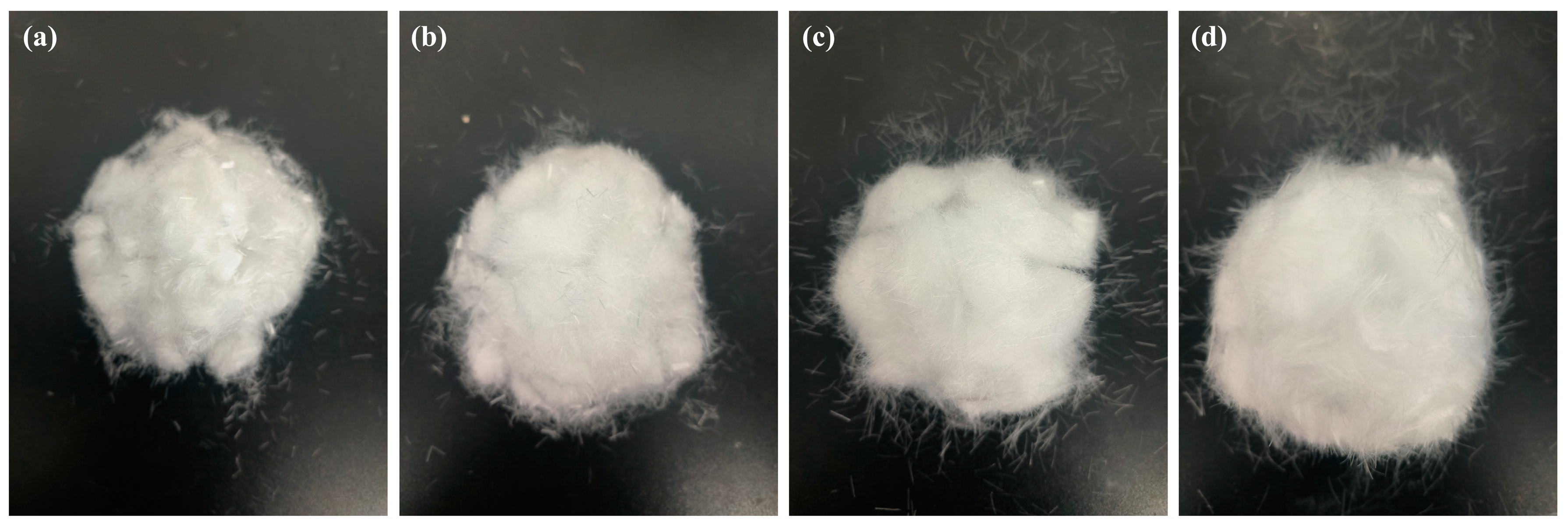

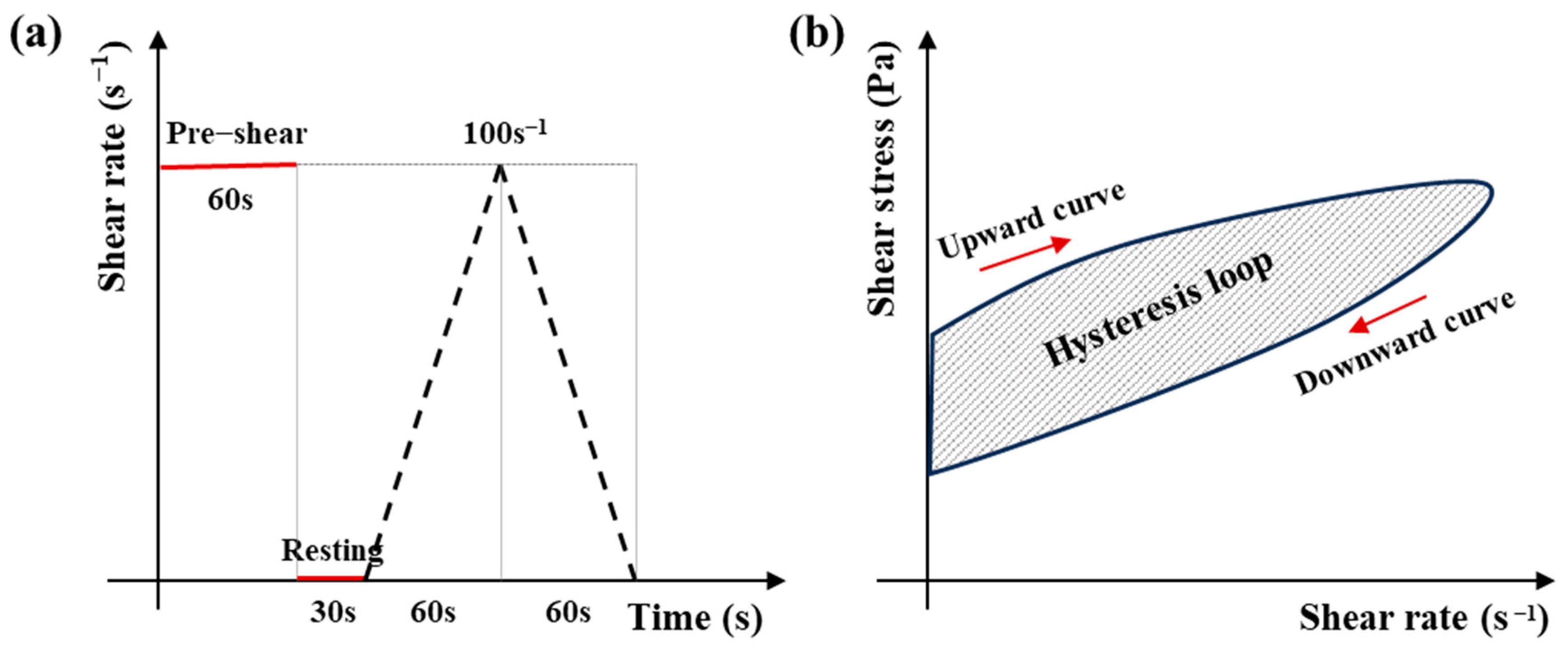

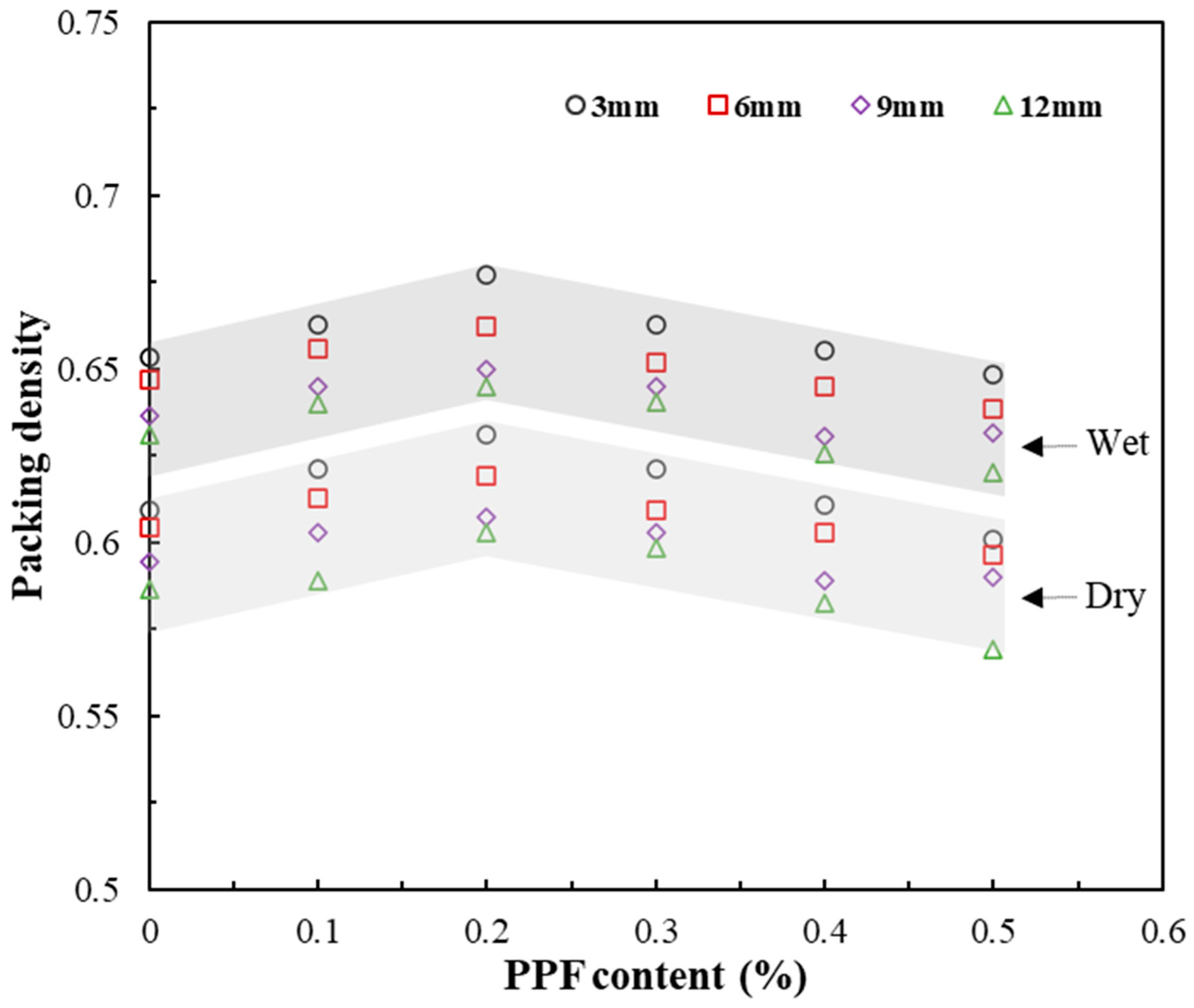
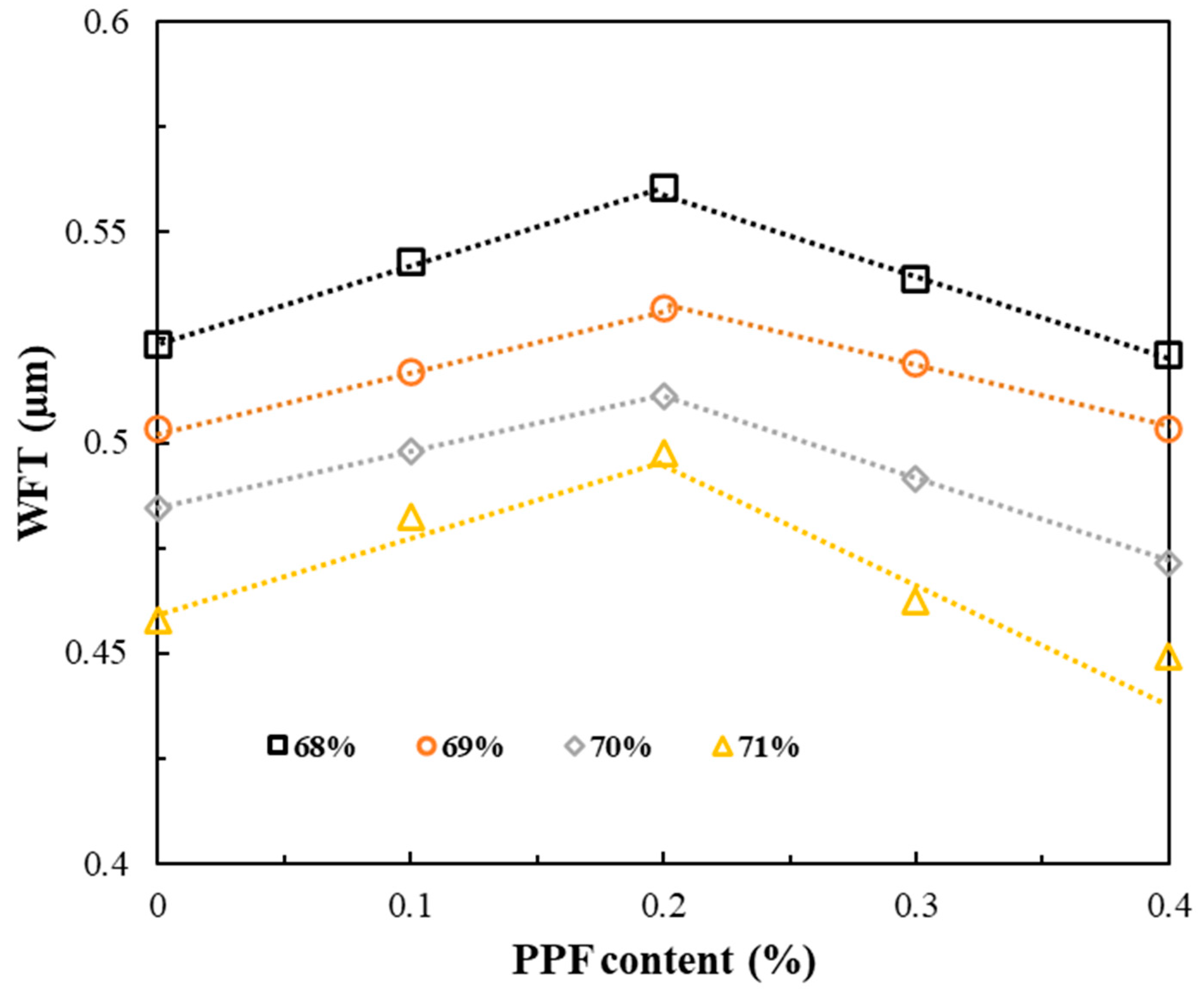
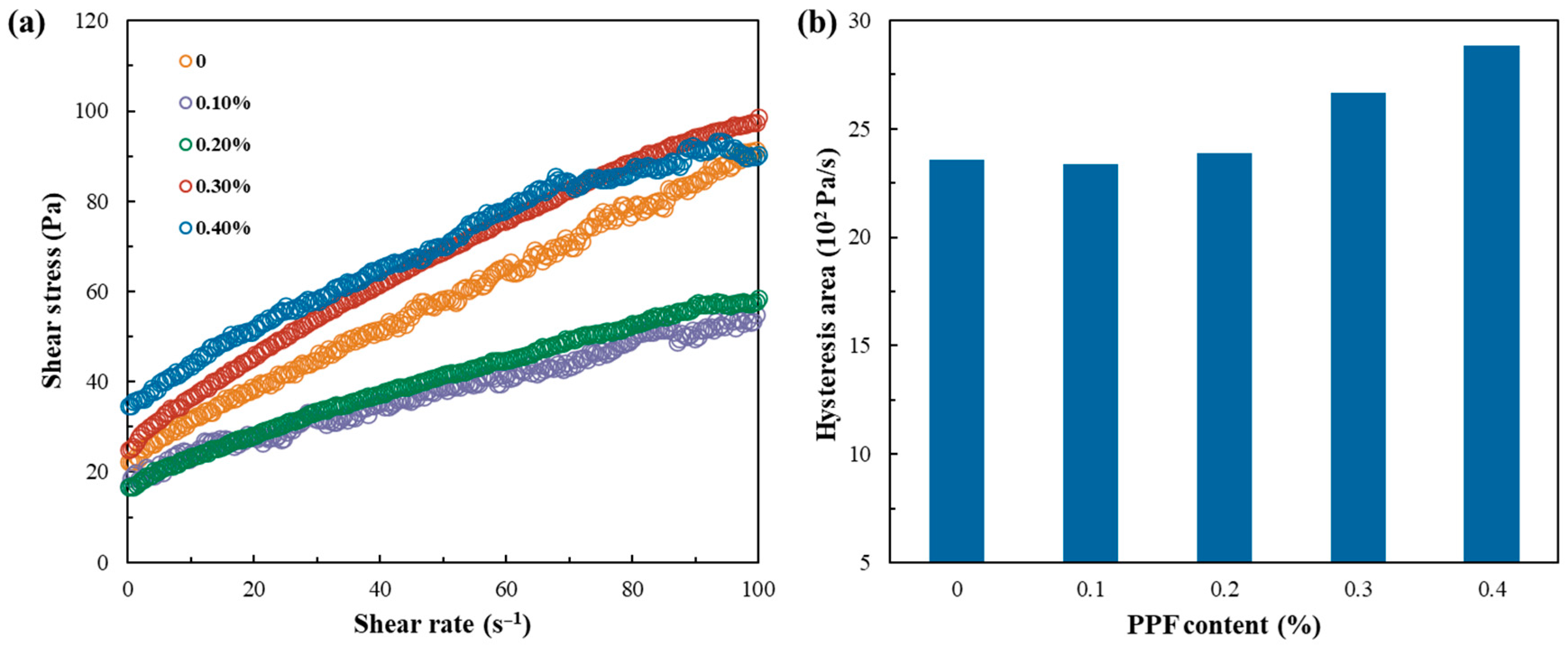
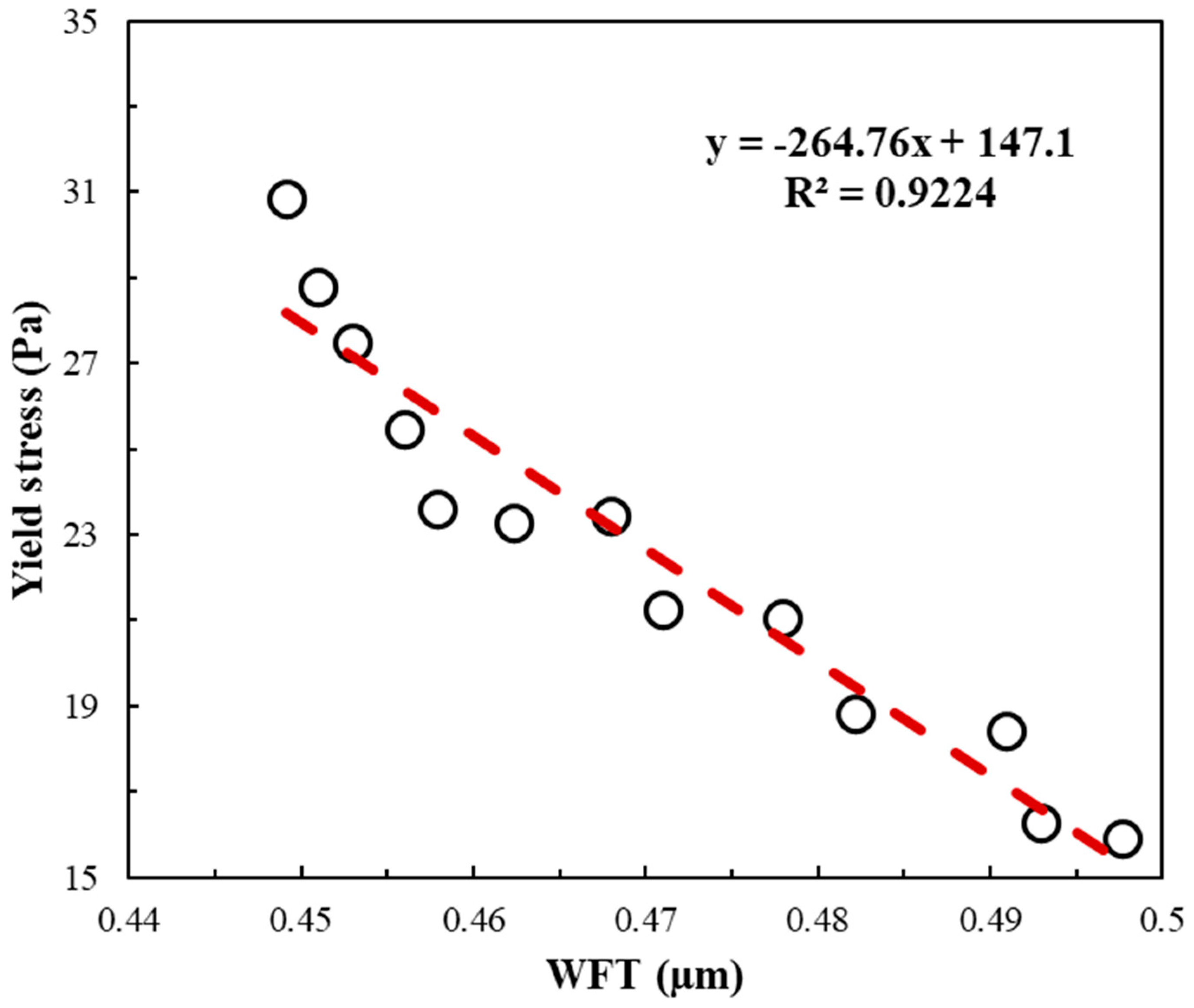
| Solid Content/% | Binder Dosage/% | PPF Content/% | PPF Length/mm |
|---|---|---|---|
| 71 | 10 | 0, 0.1, 0.2, 0.3, 0.4 | 3, 6, 9, 12 |
| PPF Content/ % | / Pa | / - | n/ - | R2/ - |
|---|---|---|---|---|
| 0 | 23.59 | 0.85 | 0.95 | 0.99 |
| 0.1 | 18.83 | 0.63 | 0.88 | 0.98 |
| 0.2 | 15.9 | 1.26 | 0.77 | 0.99 |
| 0.3 | 23.28 | 2.43 | 0.75 | 0.99 |
| 0.4 | 30.85 | 2.87 | 0.68 | 0.99 |
Disclaimer/Publisher’s Note: The statements, opinions and data contained in all publications are solely those of the individual author(s) and contributor(s) and not of MDPI and/or the editor(s). MDPI and/or the editor(s) disclaim responsibility for any injury to people or property resulting from any ideas, methods, instructions or products referred to in the content. |
© 2024 by the authors. Licensee MDPI, Basel, Switzerland. This article is an open access article distributed under the terms and conditions of the Creative Commons Attribution (CC BY) license (https://creativecommons.org/licenses/by/4.0/).
Share and Cite
Zhao, X.; Wang, H.; Luo, G.; Dai, K.; Hu, Q.; Jin, J.; Liu, Y.; Liu, B.; Miao, Y.; Zhu, K.; et al. Study on the Rheological and Thixotropic Properties of Fiber-Reinforced Cemented Paste Backfill Containing Blast Furnace Slag. Minerals 2024, 14, 964. https://doi.org/10.3390/min14100964
Zhao X, Wang H, Luo G, Dai K, Hu Q, Jin J, Liu Y, Liu B, Miao Y, Zhu K, et al. Study on the Rheological and Thixotropic Properties of Fiber-Reinforced Cemented Paste Backfill Containing Blast Furnace Slag. Minerals. 2024; 14(10):964. https://doi.org/10.3390/min14100964
Chicago/Turabian StyleZhao, Xulin, Haijun Wang, Guanghua Luo, Kewei Dai, Qinghua Hu, Junchao Jin, Yang Liu, Baowen Liu, Yonggang Miao, Kunlei Zhu, and et al. 2024. "Study on the Rheological and Thixotropic Properties of Fiber-Reinforced Cemented Paste Backfill Containing Blast Furnace Slag" Minerals 14, no. 10: 964. https://doi.org/10.3390/min14100964








